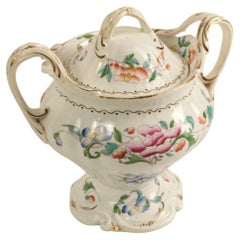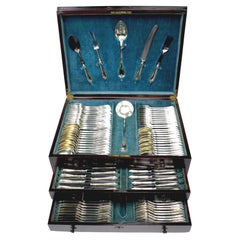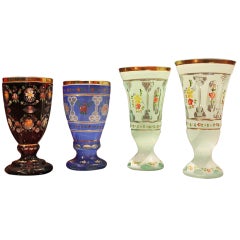Lazy Suzan Home Tableware
to
1
1
1
1
1
1
1
1
1
1
1
Hand-Painted Porcelain Sugar Bowl with Lid, c. Early 20th Century
Located in Worcester Park, GB
What makes this piece unique is its remarkable combination of ornate form and delicate hand-painted florals — a true testament to early 20th-century European porcelain craftsmanship....
Category
Early 20th Century English Rococo Revival Tableware
Materials
Porcelain
Related Items
A Fine Early 20th Century 152 Piece Austrian Flatware Set by Berndorf Alpacca
By Berndorfer Metallwarenfabrik
Located in Los Angeles, CA
A Fine Early 20th Century 152 Piece Austrian Dinnerware Flatware Set by Berndorfer Metallwaaren-Fabrik, stamped 'Berndorf Alpacca', The Neoclassical Revival style set of Alpacca flatware comprising of:
12 Fish knives
12 Salad forks
12 Salad knives
12 Pasta spoons
12 Dessert spoons
12 Coffee spoons
12 Tea spoons
12 Ice-cream spoons
1 Ice thong
1 Soup ladle
1 Serving spoon
1 Salad spoon
1 Sauce/Gravy ladle
1 Meat carving knife
1 Meat carving fork
1 Salad fork
All inside its original lined wooden storage-traveling cabinet. (See all images). Circa: Vienna, 1900-1930.
The Alpacca alloy was developed in 1823 by the German chemist Dr. Ernst August Geitner (1783-1852). It was very similar in its appearance to silver, therefore, this new alloy was first called "Argentan". It consisted of 20% nickel, 55% copper and 25% zinc. The new silver-imitating alloy soon became very popular. The Gebrueder Henninger (Henninger Bros.) proposed a similar alloy (5-30% nickel, 45-70% copper and 8-45% zinc with trace amounts of lead, tin and iron) which they called "Neusilber". Later both Argentan and Neusilber were used under the trade name of Alpacca (or Alpakka). The great advantage of the use of Alpacca alloy as the base metal for silver plating is that the appearance of the objects does not change significantly with the wearing away of the silver layer and, unlike sterling silver, it does not require frequent polishing or cleaning due to tarnishing.
The earliest known Berndorf Alpacca mark (No.1) was introduced around 1880 and used until 1891. I found it on the bottom of a 30 cl teapot bearing the inscription KRIEAU, which corresponds to the "Wiener Krieau", the famous race course in Vienna. The mark No.1 represents an oval of 3.0 x 3.6 mm size bearing the lettering "BMF ALPACCA" (which means Berndorfer Metallwaaren Fabrik or Berndorf Metalware Factory) with the "M" and "F" letters being fused. Inside the oval there is a profile of a walking bear looking down. This mark is quite rare.
BIBLIOGRAPHY
- Ingrid Haslinger, Tafelkultur Marke Berndorf, Das Niederoesterreichische Erfolgsunternehmen Arthur Krupps (Ketterl Verlag, Wien, 1998), pp.1-174, (in German).
- Dedo von Kerssenbrock-Krosigk and Claudia Kanowski, Modern Art of Metallwork (Berlin: Broehan Museum, 2001), 1-598.
- Musterbuch ueber Tafelgeraete in Alpacca-Silber I, Alpacca-Silber II und Alpacca, Unversilbert (Berndorfer Haus, Berlin, 1928), pp.1-53, (in German).
- Waltraud Neuwirth, Bluehender Jugendstil Oesterreich, Band 2: Firmen und Marken [Art Nouveau in Blossom - Austria, Vol. 2: Companies and Marks]. Vienna: Selbstverlag Dr. Waltraud Neuwirth, 1991, 1-288 (in German).
- David N. Nikogosyan, 2008, Marks of Silverplated Hollowware...
Category
Antique Early 1900s Austrian Neoclassical Revival Tableware
Materials
Alpaca, Wood
$9,850
H 18 in W 24 in D 24 in
Four Fine Bohemian, Early 20th Century, Cut Crystal Glasses
Located in Firenze, IT
Indulge in the captivating elegance of these early 20th century Bohemian cut crystal glasses, each adorned with stunning hand-painted floral motifs in vivid colors.
Crafted with exc...
Category
20th Century Czech Renaissance Tableware
Materials
Cut Glass
Mid-Century Copper & Brass Milk Creamer and Sugar Bowl with Lid, Austria, 1950s
Located in Vienna, AT
A beautiful set of a milk creamer and a sugar bowl, made of copper and brass with nice wicker handles. Executed in the 1950s by Erich Kolbenheyer, Vi...
Category
Mid-20th Century Austrian Mid-Century Modern Tea Sets
Materials
Brass, Copper
$290 / set
H 3.5 in W 4 in D 4 in
Meissen Coffee Pot, Sugar Bowl and Cream Jug with Hand-Painted Flowers
Located in København, Copenhagen
Meissen coffee pot, sugar bowl and cream jug with hand-painted flowers and gold decoration. Lids modelled with rosebuds. Early 20th century.
The co...
Category
Early 20th Century German Porcelain
Materials
Porcelain
Qing Dynasty, Chinese Antique Porcelain / Rice Bowl with Lid, 19th Century
Located in Sammu-shi, Chiba
A bowl from the Qing dynasty of China (around the 19th century).
It is a simple red and green painting.
I feel very kind and cute.
Also, when you remove the lid, you can see the g...
Category
Antique 19th Century Chinese Qing Ceramics
Materials
Porcelain
Early 20th Century Set of French Copper Lidded Pots
Located in Delft, NL
Early 20th century set of French copper lidded pots
5 lidded copper pots, French early 20th century with copper handles and knob with twist patter...
Category
Early 20th Century French Tableware
Materials
Copper
Antique Woods Ware Wincanton Hand painted Porcelain Creamer and Sugar Bowl
Located in Pomona, CA
Stunning porcelain creamer and lidded sugar bowl by Wood & Sons Woods Ware in the Wincanton Blue and Rust pattern, in about 1885s with Mark stamps on the bo...
Category
Antique Late 19th Century British Victorian Tableware
Materials
Porcelain
$350
H 5.25 in W 6 in D 4 in
Meissen Pink Rose Bowl in Hand-Painted Porcelain with Gold Edge, Early 20th C
Located in København, Copenhagen
Meissen pink rose bowl in hand-painted porcelain with gold edge. Early 20th century.
Measures: 19 x 4 cm.
In excellent condition.
Stamped.
3rd Fa...
Category
Early 20th Century German Porcelain
Materials
Porcelain
$360
H 1.58 in W 7.49 in D 7.09 in
18th Century Sugar Bowl Scotland Silver
Located in Epfach, DE
18th Century Sugar Bowl Scotland Silver
This is an exquisite sugar bowl from 18th century Scotland. This elegant bowl rests on three curved feet and has a decorative lobed rim. A fi...
Category
Antique 1780s Scottish Baroque Tableware
Materials
Sterling Silver
Early 20th Century Japanese Lacquered Wooden Spoon Shamoji
Located in Vancouver, BC
This incredibly beautiful and functional red lacquered hardwood spoon is truly one of a kind. The deep matte like finish of the red lacquer over the wood make this something worth ow...
Category
Vintage 1920s Japanese Arts and Crafts Tableware
Materials
Wood, Hardwood
Antique Meissen Blue Onion Sauce Bowl in Hand-Painted Porcelain, Late 19th C
Located in København, Copenhagen
Antique Meissen blue onion sauce bowl in hand-painted porcelain. Late 19th century.
Measures: 22 x 14 x 8.5 cm.
In excellent condition.
Stamped.
3rd factory quality.
Category
Antique Late 19th Century German Porcelain
Materials
Porcelain
$400
H 3.15 in W 8.67 in D 5.52 in
20th century Silver plate Sugar Bowl, 1950s
Located in LEGNY, FR
Very nice and original silver plate sugar bowl. The top is removable to put the sugar in. Good quality and condition.
Category
Vintage 1950s French Sheffield and Silverplate
Materials
Silver Plate


